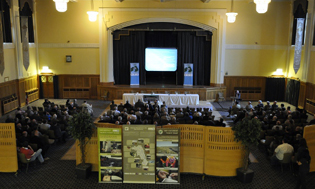 On Tuesday 11th June the management group of the Celtic Sea Trout Project met in Dumfries and gave a series of talks to invited representatives of the rivers around the Solway Firth. Anglers, owners and fishery managers were given presentations on the various aspects of the project then the floor was opened for questions.
On Tuesday 11th June the management group of the Celtic Sea Trout Project met in Dumfries and gave a series of talks to invited representatives of the rivers around the Solway Firth. Anglers, owners and fishery managers were given presentations on the various aspects of the project then the floor was opened for questions.
Outcomes from the meeting were that firstly, there is a high degree of concern regarding the reduced numbers of sea trout experienced around the Solway and other areas that drain into the Celtic Sea. Secondly that our knowledge of sea trout and its complex life cycle, both in the fresh water and marine environment is in its infancy and we have much more to learn about this species of fish.
The Celtic Sea Trout Project has been a three year research programme and has involved renowned scientists from the UK and Ireland in sea trout biology, ecology and genetics. At the start of the project very little was actually known about sea trout and why there has been such a dramatic decline in their populations. The aims of the project were to understand more about sea trout stocks in the Irish Sea using a variety of methods including genetic analysis, microchemistry, freshwater and marine modelling and to compile and analyse existing data on sea trout stocks to reference the research against.
During the life of the project over 8000 scale samples and 5500 genetic samples were taken from over 100 rivers around the Irish Sea. That is the largest collection of baseline samples known to exist on sea trout and will be a valuable resource for future research. Phil McGinnity presented the findings of the genetic analysis and how it was used to track sea trout movements within the Irish Sea, demonstrating that sea trout actually travel far further that anyone had ever imagined with Solway sea trout being found on the south east coast of Ireland, over 300km away. This raises questions as to where else our sea trout may be going and future management.
It became clear through the course of the evening what a huge task it has been pulling together the existing data on sea trout catches and analysing them for trends that could help explain the life history choices that sea trout make throughout their lives. One thing that did stand out however was that there are common trends throughout the whole of the UK and Ireland and that whatever is happening is not just a local phenomenon. Something else is going on!
The main points that resulted from the evening were:
- Sea trout are migrating further than anyone thought
- Common trends can be seen throughout the UK and the decline is not a local phenomenon – something else is going on
- Scale reading is showing repeat spawning and that sea trout are producing eggs over possible 5-7 years of their lives – that is a lot of eggs!
- Herling have an important role to play and could be our repeat spawners of the future
- Very little is understood about sea trout but the CSTP has made a significant step forward in developing comprehensive baseline data
- Further research is needed regarding climate change and food availability
Data is still being collated but it is anticipated that there will be practical management applications produced from this work.
